Jan
02
2024
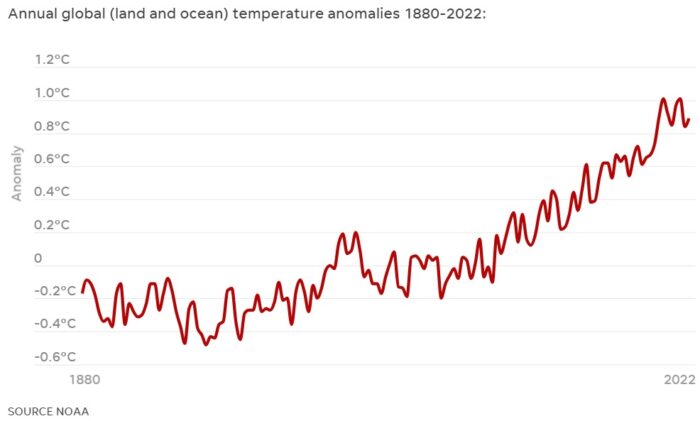 What everyone knew was coming is now official – 2023 was the warmest year on record. This means we can also say that the last 10 years are the hottest decade on record. 2023 dethrones 2016 as the previous warmest year and bumps 2010 out of the top 10. Further, in the last half of the year, many of the months were the hottest months on record, and by a large margin. September’s average temperature was 1.44 C above pre-industrial levels, beating the previous record set in 2020 of 0.98 C. The average for 2023 is 1.4 C, beating the previous record in 2016 of 1.2 C. This also makes 2023 probably the warmest year in the last 125,000 years.
What everyone knew was coming is now official – 2023 was the warmest year on record. This means we can also say that the last 10 years are the hottest decade on record. 2023 dethrones 2016 as the previous warmest year and bumps 2010 out of the top 10. Further, in the last half of the year, many of the months were the hottest months on record, and by a large margin. September’s average temperature was 1.44 C above pre-industrial levels, beating the previous record set in 2020 of 0.98 C. The average for 2023 is 1.4 C, beating the previous record in 2016 of 1.2 C. This also makes 2023 probably the warmest year in the last 125,000 years.
There is no mystery as to why this is happening, and it’s exactly what scientists predicted would happen. Remember the global warming “pause” that was allegedly happening between 1998 and 2012? This was the pause that never was, a short term fluctuation in the long term trend and a bit of statistical voodoo. Global warming deniers were declaring that global warming was over, it was never real, it was just a statistical fluke and the world was regressing back to the mean. Meanwhile, scientists said the long term trend had not altered and predicted the next decade would be even warmer. In retrospect, it turns out that during the alleged “pause” more heat was going into the oceans and was not fully reflected in surface temperatures.
The best test of a scientific hypothesis is its ability to make predictions about future data. The deniers were predicting that the Earth would simply return to baseline temperatures, while the scientific community were united in predicting that the next decade (now the past decade) would see continued warming.
Continue Reading »
Jan
03
2023
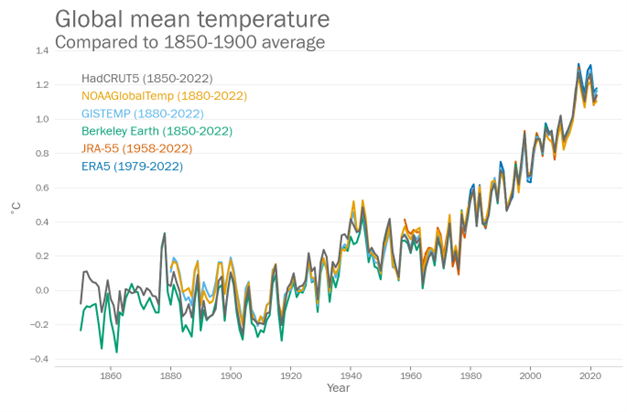 Happy New Year to all my readers.
Happy New Year to all my readers.
Early in each new year I like to see what the preliminary reports are for the climate over the past year. Final number crunching won’t be available for months, and it may take more than a year for the final tweaks to be reported and reviewed. But we do have a preliminary estimate of the temperature over the last year. The World Meteorological Organization reports:
The global average temperature in 2022 is estimated to be about 1.15 [1.02 to 1.28] °C above the 1850-1900 average. 2015 to 2022 are likely to be the eight warmest years on record. La Niña conditions have dominated since late 2020 and are expected to continue until the end of 2022. Continuing La Niña has kept global temperatures relatively «low» for the past two years – albeit higher than the last significant La Niña in 2011.
It looks like 2022 will be the fourth hottest year on record globally. Some specific locations had their warmest year, such as the UK and Spain (and perhaps most of Europe). As the WMO points out, we are in the middle of a La Niña cycle, which brings cooler temperatures globally. That is a short term fluctuation on the longer term trend. This also means that as we shift into an El Niño cycle we are likely to break new records.
I feel compelled to point all this out (as I am sure many scientists and science communicator will) because it is a critically important piece of information. But I also want to put it into a broader long term context. I have been engaged in skeptical activism now for 27 years, and followed many skeptical topics for longer than that. There is one extremely important pattern that emerges when you cover a topic for a long time – scientifically valid concepts tend to not only accumulate evidence but the evidence gets better and builds on itself. Meanwhile, pseudosciences do not display this pattern. They tend to go around in circles with low quality evidence. You can see this pattern across multiple disciplines.
Continue Reading »
Jul
26
2022
 It should come as a surprise to no one that the fossil fuel industry has been financing a vast public relations campaign over the last three decades to sow confusion and doubt about human-caused climate change. This is already well established. One Harvard study, for example, focusing on ExxonMobil, found:
It should come as a surprise to no one that the fossil fuel industry has been financing a vast public relations campaign over the last three decades to sow confusion and doubt about human-caused climate change. This is already well established. One Harvard study, for example, focusing on ExxonMobil, found:
That analysis showed that ExxonMobil misled the public about basic climate science and its implications. They did so by contributing quietly to climate science, and loudly to promoting doubt about that science.
Now, the BBC reports on two people who worked with a PR firm specifically to deny the science of climate change who are now telling their story, adding some more details and focus to the tale. Don Rheem and Terry Yosie worked for E Bruce Harrison, an industry PR guru, who, starting in 1992, landed the campaign to work for the Global Climate Coalition (GCC), an industry group comprised of oil, coal, auto, utilities, steel, and rail industries. What do all these industries have in common? They all contribute significantly to green house gas emissions. And why 1992? Because that is the year of the election that would replace an oil-friendly president with one more friendly to environmental causes, and with a vice president who was a climate change activist. The handwriting was on the wall.
And Harrison had a vision – he had honed his tactics fighting auto industry regulations and spreading doubts about the harms of smoking for the tobacco industry. He recruited a team and made climate change denial his primary focus. The tactics his firm used for the GCC were largely the same – they put out constant opinion pieces, background pieces for journalists, and paid advertising emphasizing doubt about climate science. For example, in a 1994 booklet they claimed:
The greenhouse effect is a natural phenomenon produced by naturally occurring atmospheric gases. To date, there is no evidence to demonstrate the climate has changed as a result of any “enhancement” to this natural phenomenon by man-made greenhouse gases.
Continue Reading »
Jan
16
2020
 This is going to be a long struggle, perhaps endless. Antivaxxers have been around since there have been vaccines, for over two hundred years, so there is no reason to expect they are going anywhere. Rather, we need an equally permanent anti-antivaxxer movement (otherwise known as the skeptical movement).
This is going to be a long struggle, perhaps endless. Antivaxxers have been around since there have been vaccines, for over two hundred years, so there is no reason to expect they are going anywhere. Rather, we need an equally permanent anti-antivaxxer movement (otherwise known as the skeptical movement).
After the Disneyland measles outbreak, there has been political pressure to push back against antivaxxers and strengthen our vaccine requirements. This resulted, for example, in SB277 in California, a law to remove personal beliefs as a reason for vaccine exemption. The return of measles in the last few years (1,282 cases in 2019 in the US, more than 140,000 worldwide) has fueled similar push back. But the antivaxxers have not taken this lying down. They are now fired up to defend their debunked conspiracy theories and pseudoscience at the expense of public health.
A recent clash in New Jersey shows the intensity on both sides. Bill S2173 narrowly failed in the senate amid vocal protests by the antivaxxers. The bill would have removed religious exemptions for vaccine requirements for schools and daycare. In order to save the bill, proponents amended it to apply only to public schools, but this only cost more support as some senators correctly pointed out this will only concentrate the unvaccinated in private schools and result in more outbreaks. Proponents of the bill vow to revise it and try again.
It’s clear that there is now intensity on both sides. One side, however, is completely wrong, something I rarely say but there are issues where this is clearly true. Antivaxxers claim, falsely, that vaccines don’t work, they cause more harm than good, they are linked to autism and other serious complications, and even that there is a corporate-government conspiracy to hide these facts. Debunking these claims will take many many articles, but fortunately I and my colleagues have already written them. You can look through here and also here for articles addressing pretty much every antivaxxer claim. But it is an unfortunate reality that there is always an asymmetry in these cases, because it takes much more time and effort to debunk a false claim than to make it in the first place.
Continue Reading »
May
17
2019
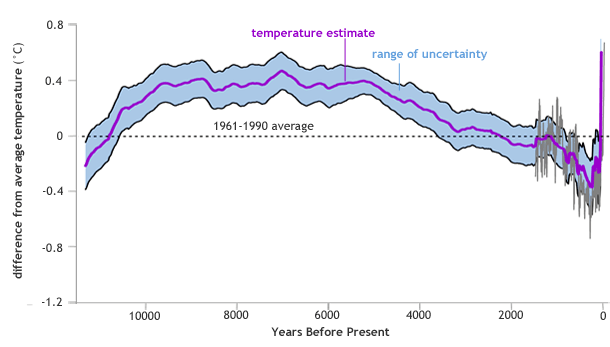 Whenever the issue of climate comes up on this blog (or even just in the comments on unrelated articles), climate change deniers make an appearance. Consistently they use terrible arguments – relying on straw men, factually incorrect statements, deliberately confusing and blurring the lines, and committing just about every logical fallacy. They are also the same recycled arguments I see over and over, regardless of how many times they are refuted. That is how you know a position is intellectually dishonest, it never changes. It just moves around to the same repertoire of refuted positions.
Whenever the issue of climate comes up on this blog (or even just in the comments on unrelated articles), climate change deniers make an appearance. Consistently they use terrible arguments – relying on straw men, factually incorrect statements, deliberately confusing and blurring the lines, and committing just about every logical fallacy. They are also the same recycled arguments I see over and over, regardless of how many times they are refuted. That is how you know a position is intellectually dishonest, it never changes. It just moves around to the same repertoire of refuted positions.
A systematic refutation of these bad arguments requires a book, and there are many good resources out there, but I just want to focus on one argument in this article – the notion that the climate is always changing. This, of course, is true. It’s simply not a refutation in any way of the scientific position of anthropogenic global warming.
This is one of the many positions of the deniers. First they will argue that the climate is not changing. When the evidence for that is too irrefutable, then they say that it is always changing. This is also where the unmitigated hubris comes in – they bring up the point that there are natural trends in climate change as if this is news to anyone. Oh really, you don’t say? The climate naturally changes? I wonder if the world’s climate scientists, who have dedicated their careers to thinking deeply and carefully about things like the climate, have ever encountered that notion before. You should tell them.
Or, this is just a suggestion, you can take a moment to try to understand what scientists actually think rather than just swallowing science-denying propaganda whole. If a scientific idea is comprehensible to you as a non-expert, it’s a pretty good bet the experts have thought of it. You certainly shouldn’t assume that they haven’t, or you are somehow smarter than all the climate scientists in the world. Seriously – get some perspective.
Continue Reading »
Mar
08
2019
 Bangladesh has cleared the way for the cultivation of golden rice, with the first plantings 2-3 months away. This is great news. Golden rice is genetically modified to have higher levels of beta-carotene, a precursor to vitamin A. Bangladesh is a perfect country for use of this crop because of high levels of vitamin A deficiency, and rice is a staple crop.
Bangladesh has cleared the way for the cultivation of golden rice, with the first plantings 2-3 months away. This is great news. Golden rice is genetically modified to have higher levels of beta-carotene, a precursor to vitamin A. Bangladesh is a perfect country for use of this crop because of high levels of vitamin A deficiency, and rice is a staple crop.
According to the WHO:
An estimated 250 000 to 500 000 vitamin A-deficient children become blind every year, half of them dying within 12 months of losing their sight.
That is a huge health burden, mostly on poor children. In response to this, an international consortium has been working on potential solutions using biotechnology.
Rice is the primary food staple for over half of the world’s population, but it is also a very poor source of essential micronutrients and protein. Accordingly, human micronutrient deficiencies are prevalent in many rice-consuming regions, especially throughout the developing world where poverty exacerbates the problem of insufficient intake of animal products and other nutrient-dense foods. To reduce the global incidence of these nutritional disorders, a transgenic approach will be applied to improve the nutritional value of rice, with a specific focus on combining provitamin A and vitamin E in the rice grain and to increase the protein content to achieve a balanced composition of essential amino acids. Golden Rice will be combined with high iron lines. In addition, the knowledge necessary to enhance the bioavailability of iron and zinc in target crops will be generated. This will be achieved by identifying the corresponding QTLs in the model plant Arabidopsis. Golden Rice and other engineered rice lines with stacked traits will be incorporated into ongoing breeding and seed delivery programmes for developing countries. The products generated will be made freely available to low-income farmers to address these deficiencies inherent to rice-based diets on a global scale.
Sounds like a solid plan – fortify staple crops with needed micronutrients and make them freely available to poor farmers. No reasonable person could have a problem with that. But of course ideologues are rarely reasonable, almost by definition. And the propaganda they spread can be very effective at misinformation.
Continue Reading »
Mar
05
2019
 I know this is old news – or at least it should be – but it bears repeating, especially as we are in the midst of a resurgence of measles. There is no link between the mumps, measles, and rubella vaccine (MMR) and autism, or any neurological disorder. A new study confirms this lack of association. This should go a long way to reassure the vaccine hesitant that the MMR vaccine at least is safe and should not be avoided.
I know this is old news – or at least it should be – but it bears repeating, especially as we are in the midst of a resurgence of measles. There is no link between the mumps, measles, and rubella vaccine (MMR) and autism, or any neurological disorder. A new study confirms this lack of association. This should go a long way to reassure the vaccine hesitant that the MMR vaccine at least is safe and should not be avoided.
This is a Danish study, and the largest study of the MMR vaccine and autism to date – “657,461 children born in Denmark from 1999 through 31 December 2010, with follow-up from 1 year of age and through 31 August 2013.” They found:
During 5,025,754 person-years of follow-up, 6517 children were diagnosed with autism (incidence rate, 129.7 per 100,000 person-years). Comparing MMR-vaccinated with MMR-unvaccinated children yielded a fully adjusted autism hazard ratio of 0.93 (95% CI, 0.85 to 1.02). Similarly, no increased risk for autism after MMR vaccination was consistently observed in subgroups of children defined according to sibling history of autism, autism risk factors (based on a disease risk score) or other childhood vaccinations, or during specified time periods after vaccination.
Overall there was no association between getting the MMR vaccine and later being diagnosed with autism. Further, there was no correlation when looking specifically at children who have a sibling with autism, and therefore might constitute a susceptible subpopulation. Further still, there was no clustering of autism diagnosis following the MMR vaccine administration, as might be expected if there was a causal link. This is a very large study with an adequate study design, so that if there were any increased risk of developing autism from the MMR vaccine we should be seeing it in this data – and we don’t.
Continue Reading »
Jan
15
2019
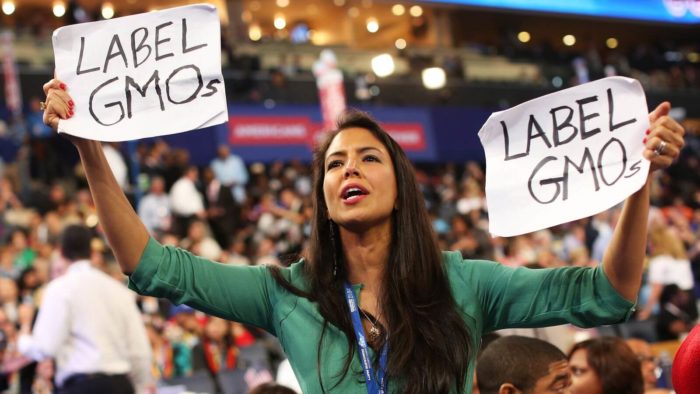 I have written extensively about GMOs (gentically modified organisms) here, and even dedicated a chapter of my book to the topic, because it is the subject about which the difference between public opinion and the opinion of scientists is greatest (51%). I think it’s clear that this disparity is due to a deliberate propaganda campaign largely funded by the organic lobby with collaboration from extreme environmental groups, like Greenpeace.
I have written extensively about GMOs (gentically modified organisms) here, and even dedicated a chapter of my book to the topic, because it is the subject about which the difference between public opinion and the opinion of scientists is greatest (51%). I think it’s clear that this disparity is due to a deliberate propaganda campaign largely funded by the organic lobby with collaboration from extreme environmental groups, like Greenpeace.
This has produced an extreme, if not a unique, challenge for science communicators. Also – there are direct implications for this, as the political fight over GMO regulation and acceptance is well underway. The stakes are also high as we are facing challenges feeding a growing population while we are already using too much land and there really isn’t more we can press into agriculture. (Even if there are other ways to reduce our land use, that does not mean we should oppose a safe and effective technology that can further reduce it.)
A new study published in Nature may shed further light on the GMO controversy. The authors explore the relationship between knowledge about genetics and attitudes toward GMOs.
In a nationally representative sample of US adults, we find that as extremity of opposition to and concern about genetically modified foods increases, objective knowledge about science and genetics decreases, but perceived understanding of genetically modified foods increases. Extreme opponents know the least, but think they know the most.
Continue Reading »
Dec
11
2017
 Paltrow has defended her “lifestyle brand” by saying that they are just giving women choices, and being open. Nonsense – don’t be swayed by such distractions.
Paltrow has defended her “lifestyle brand” by saying that they are just giving women choices, and being open. Nonsense – don’t be swayed by such distractions.
I unapologetically support reason and scholarship as critical values for human civilization. This is increasingly true as our world gets more complex, as the stakes get higher, the margins for error lower, and as our culture and economy are increasingly global.
We cannot get by just shooting from the hip. We need people with specific expertise who transparently follow a process that is logically valid and based on evidence. We need standards of scholarship and intellectual rigor that are up to the challenges we face. We also need to make this work within an open and democratic society, where public opinion matters.
What all this means is that it is more important than ever to have a well-educated public, and for our public discourse to respect standards of honesty and excellence. It matters if people understand and accept what experts have to say about vaccine safety and effectiveness, the evidence base for manmade climate change, the safety of GMOs, and the nature of health and disease.
Continue Reading »
Sep
18
2017
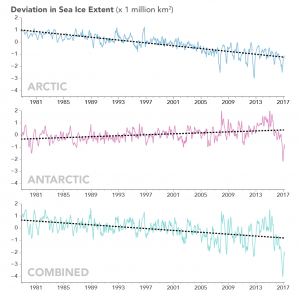 The extent of Arctic sea ice is an important marker for global climate change. In the last forty years it also has been unequivocally shrinking. NASA has been tracking Arctic sea ice extent at different times of the year, with the September minimum being an important point of comparison. Like any chaotic system there are going to be short term fluctuations, but the long term trend is crystal clear. Look at the graph and look at the video on the NASA site linked above – the shrinking is clear.
The extent of Arctic sea ice is an important marker for global climate change. In the last forty years it also has been unequivocally shrinking. NASA has been tracking Arctic sea ice extent at different times of the year, with the September minimum being an important point of comparison. Like any chaotic system there are going to be short term fluctuations, but the long term trend is crystal clear. Look at the graph and look at the video on the NASA site linked above – the shrinking is clear.
The first estimates for September 2017 are in and they are consistent with the overall trend. Arctic sea ice’s most recent maximum for the September minimum was in 1996 at 7.87 million square km. The minimum minimum was in 2012 at 3.62 million sq km – less than half. This year the minimum is estimated to be 4.7 million sq km, slightly more than 2016. All of the last 10 years are below the average for the previous 30 years.
This past year we had a warm winter, which led to the lowest amount of March Arctic sea ice on record, but a cool summer allowed the Arctic ice to rebound a bit.
All of this adds to the strong scientific consensus that the globe is warming and this trend is largely due to human factors (not natural cycles). But as you probably know, there is a well-financed campaign of denial, ideologically and financially motivated, to muddy the waters and create doubt and confusion about this scientific consensus. This is easy to do with complex scientific questions.
Continue Reading »
 What everyone knew was coming is now official – 2023 was the warmest year on record. This means we can also say that the last 10 years are the hottest decade on record. 2023 dethrones 2016 as the previous warmest year and bumps 2010 out of the top 10. Further, in the last half of the year, many of the months were the hottest months on record, and by a large margin. September’s average temperature was 1.44 C above pre-industrial levels, beating the previous record set in 2020 of 0.98 C. The average for 2023 is 1.4 C, beating the previous record in 2016 of 1.2 C. This also makes 2023 probably the warmest year in the last 125,000 years.
What everyone knew was coming is now official – 2023 was the warmest year on record. This means we can also say that the last 10 years are the hottest decade on record. 2023 dethrones 2016 as the previous warmest year and bumps 2010 out of the top 10. Further, in the last half of the year, many of the months were the hottest months on record, and by a large margin. September’s average temperature was 1.44 C above pre-industrial levels, beating the previous record set in 2020 of 0.98 C. The average for 2023 is 1.4 C, beating the previous record in 2016 of 1.2 C. This also makes 2023 probably the warmest year in the last 125,000 years.
 Happy New Year to all my readers.
Happy New Year to all my readers. It should come as a surprise to no one that the fossil fuel industry has been financing a vast public relations campaign over the last three decades to sow confusion and doubt about human-caused climate change. This is already well established.
It should come as a surprise to no one that the fossil fuel industry has been financing a vast public relations campaign over the last three decades to sow confusion and doubt about human-caused climate change. This is already well established.  This is going to be a long struggle, perhaps endless. Antivaxxers have been around since there have been vaccines, for over two hundred years, so there is no reason to expect they are going anywhere. Rather, we need an equally permanent anti-antivaxxer movement (otherwise known as the skeptical movement).
This is going to be a long struggle, perhaps endless. Antivaxxers have been around since there have been vaccines, for over two hundred years, so there is no reason to expect they are going anywhere. Rather, we need an equally permanent anti-antivaxxer movement (otherwise known as the skeptical movement). Whenever the issue of climate comes up on this blog (or even just in the comments on unrelated articles), climate change deniers make an appearance. Consistently they use terrible arguments – relying on straw men, factually incorrect statements, deliberately confusing and blurring the lines, and committing just about every logical fallacy. They are also the same recycled arguments I see over and over, regardless of how many times they are refuted. That is how you know a position is intellectually dishonest, it never changes. It just moves around to the same repertoire of refuted positions.
Whenever the issue of climate comes up on this blog (or even just in the comments on unrelated articles), climate change deniers make an appearance. Consistently they use terrible arguments – relying on straw men, factually incorrect statements, deliberately confusing and blurring the lines, and committing just about every logical fallacy. They are also the same recycled arguments I see over and over, regardless of how many times they are refuted. That is how you know a position is intellectually dishonest, it never changes. It just moves around to the same repertoire of refuted positions. Bangladesh has cleared the way for the cultivation of golden rice, with the first plantings 2-3 months away. This is great news.
Bangladesh has cleared the way for the cultivation of golden rice, with the first plantings 2-3 months away. This is great news.  I know this is old news – or at least it should be – but it bears repeating, especially as we are in the midst of a resurgence of measles. There is no link between the mumps, measles, and rubella vaccine (MMR) and autism, or any neurological disorder.
I know this is old news – or at least it should be – but it bears repeating, especially as we are in the midst of a resurgence of measles. There is no link between the mumps, measles, and rubella vaccine (MMR) and autism, or any neurological disorder.  I have written
I have written  Paltrow has defended her “lifestyle brand” by saying that they are just giving women choices, and being open. Nonsense – don’t be swayed by such distractions.
Paltrow has defended her “lifestyle brand” by saying that they are just giving women choices, and being open. Nonsense – don’t be swayed by such distractions. The extent of Arctic sea ice is an important marker for global climate change. In the last forty years it also has been
The extent of Arctic sea ice is an important marker for global climate change. In the last forty years it also has been 




